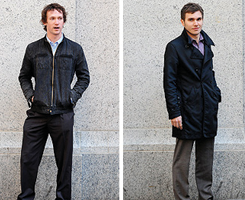How to Dress "Business Casual"

Despite being overly generic, umbrella terms for different styles of dress generally get the point across in a reasonably clear manner. When someone says “euro,” you immediately think tight pants, aggressive dress shirts, and unsafe amounts of hair gel. “Formal business” evokes jackets and ties for men, power suits and collars for women. “Casual Friday chic” is a term no one actually uses, but you know that someone is bound to wear Crocs.
Traditional business dress is seen as a uniform; it does for the office what uniforms do for prep schools. It simplifies decision-making and makes hierarchies easy to read. We all want to identify the upperclassmen when we step into the elevator.
When the uniform is put aside, people feel free to set aside the power signals and express their style sense. But they often fail to recognize that, just as in high school, they're still being judged. It's human nature to respond to visual cues. Bell-bottomed pants may be back, says Ms. Kan, but "the best dressers resist the urge to wear them, because clients balk when you show up looking like Charo."
A good rule of thumb is to err more on the “business” side than the “casual” side. Better to look a bit stiff but respectable than to stand out for being overly relaxed—remember you should just be trying to get your coworkers and superiors to treat you professionally, not date you. This approach is especially useful if you’re new. Start out on the conservative side and then take cues from other people in the office to figure out what’s deemed appropriate.





Comments
(0)POST YOUR COMMENT